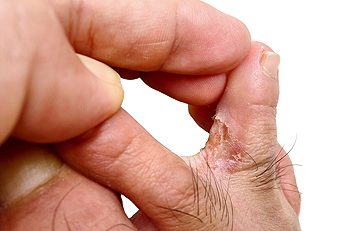
Athlete’s foot is a fungal infection that affects the feet and toes, producing symptoms such as red, flaky, or cracked skin, especially between the toes or on the soles. Athlete’s foot may also cause soggy or peeling areas, burning or stinging sensations, and itching that worsens after removing socks or shoes. In some cases, painful blisters or ulcers that leak fluid may appear. There are three main types of athlete’s foot. Toe web infections usually begin between the fourth and fifth toes and may cause peeling, rash-like redness, and, in severe cases, green discoloration or foul-smelling discharge. Moccasin infections often begin with soreness and dry, cracked skin on the soles and heels and can cause thickened or discolored toenails that loosen or fall off. Vesicular infections involve small, fluid-filled blisters on the soles or other areas of the feet, and may lead to open sores or bacterial infection. A podiatrist can determine the type of athlete’s foot infection and recommend appropriate care. If you have any of these symptoms, it is suggested that you schedule an appointment with a podiatrist for an exam and appropriate treatment options.
Athlete’s foot is an inconvenient condition that can be easily reduced with the proper treatment. If you have any concerns about your feet and ankles, contact Tanya R. Sellers-Hannibal, DPM from Maryland. Our doctor will treat your foot and ankle needs.
Athlete’s Foot: The Sole Story
Athlete's foot, also known as tinea pedis, can be an extremely contagious foot infection. It is commonly contracted in public changing areas and bathrooms, dormitory style living quarters, around locker rooms and public swimming pools, or anywhere your feet often come into contact with other people.
Solutions to Combat Athlete’s Foot
- Hydrate your feet by using lotion
- Exfoliate
- Buff off nails
- Use of anti-fungal products
- Examine your feet and visit your doctor if any suspicious blisters or cuts develop
Athlete’s foot can cause many irritating symptoms such as dry and flaking skin, itching, and redness. Some more severe symptoms can include bleeding and cracked skin, intense itching and burning, and even pain when walking. In the worst cases, Athlete’s foot can cause blistering as well. Speak to your podiatrist for a better understanding of the different causes of Athlete’s foot, as well as help in determining which treatment options are best for you.
If you have any questions please feel free to contact our office located in Owings Mills, MD . We offer the newest diagnostic and treatment technologies for all your foot and ankle needs.
